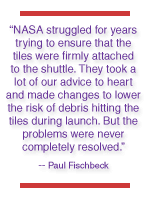|
|
||
|
|
|
 Professor's Study Focused on Space Shuttle Tiles � A technical report co-authored by Carnegie Mellon Professor Paul Fischbeck more than a decade ago warned that the space shuttle could be destroyed if tiles protecting critical wing parts were damaged by debris. As the Columbia tragedy that killed all seven astronauts aboard on Feb. 1 continues to unfold, the shuttle tiles have received much of the focus. An analysis of at least 30 shuttle flights found just 15 percent of the tiles that make up the shuttle's heat shield account for about 85 percent of the risk of a burn-through that would destroy the orbiter. The researchers, Fischbeck and Stanford University's Elisabeth Pate-Cornell, studied the first 30 or so flights of the space shuttles and identified segments of the 20,000-plus protective tiles that were most prone to fail and cause a catastrophic event. The report included a recommendation that NASA take steps to prevent foam chunks from falling off the external tank and striking those "risk critical tiles" that were more sensitive to debris strikes and weakened bonding and that protected some of the subsystems most critical to the ship's safe landing.
A patch of foam insulation breaking off from the shuttle's external fuel tank during the launch and striking tiles on the underside of the left wing is being studied as researchers try to determine the actual cause of the shuttle destruction. Fischbeck and his colleagues made an initial report to NASA on their findings in 1990, and they later published follow-up papers on the research in 1993-1994. They conducted a risk analysis of the shuttle's thermal protection tile system and found that the spacecraft was highly vulnerable to tiles being knocked off or broken by insulation falling from the fuel tank and from other debris. In a follow-up to the report, Fischbeck said he studied debris strikes during the first 50 shuttle launches and concluded that about 25 thermal tiles per flight sustained damage of at least one inch. The analysis found that the most vulnerable parts of the shuttle were the undersides of the wings close to the fuselage and right under the crew compartment. NASA experts have reported that data from the Columbia shows a sudden temperature rise—a marker for failed tiles—in the left wheel well, an area Fischbeck's and Pate-Cornell's report said was a critical risk. The report also said that a key problem faced by NASA was training technicians to glue tiles on the hull of the space shuttle and then test the strength of the bonding. An adhesive used for the tiles hardened more quickly if it was wet, and the report said NASA found one technician helping the process along by spitting into the glue. However, wetting the glue compromised the bond. To locate loose tiles, workers conducted a pull test, using a special machine, but the study found this technique missed some problems. The best test was a "wiggle test" that only experienced technicians learned to do, the report said. Fischbeck said NASA has made improvements in protecting and maintaining the tile system since his early study. Foam insulation on the fuel tank has been changed and there are stricter limits on the amount of ice allowed on the fuel tank before a launch. The report has generated interest at a variety of news outlets including: NBC, ABC, CBS, CNN, Fox News, The New York Times, The Washington Post, The Houston Chronicle, The Wall Street Journal, NPR and a litany of trade and other national publications. � � � � � �
�
Top�
�
�
Chriss Swaney
|
|
This Issue's Headlines || Carnegie Mellon News Home || Carnegie Mellon Home |
||
 "NASA struggled for years trying to ensure that the tiles were firmly attached to the shuttle," said Fischbeck, professor of engineering and public policy and social and decision sciences. "They took a lot of our advice to heart and made changes to lower the risk of debris hitting the tiles during launch. But the problems were never completely resolved."
"NASA struggled for years trying to ensure that the tiles were firmly attached to the shuttle," said Fischbeck, professor of engineering and public policy and social and decision sciences. "They took a lot of our advice to heart and made changes to lower the risk of debris hitting the tiles during launch. But the problems were never completely resolved."